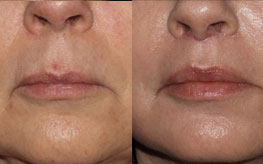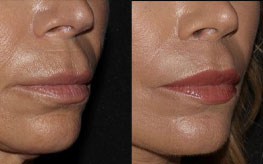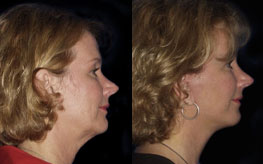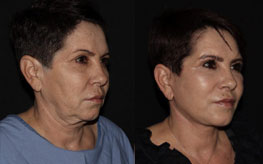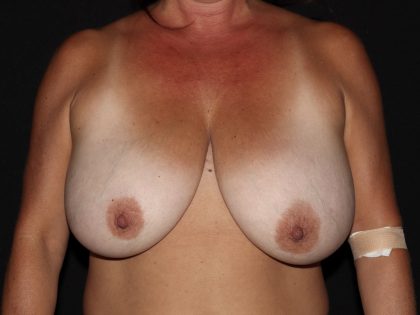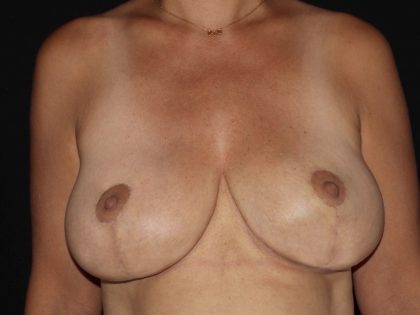Breast Reduction
Conveniently located to serve the areas of San Diego, CA

Also known as reduction mammaplasty, breast reduction surgery removes excess breast fat, glandular tissue and skin to achieve a breast size in proportion with your body and to alleviate the discomfort associated with overly large breasts.
For more information about our breast reduction procedure, please contact us online or call us at 888-463-9532. We look forward to helping you look your best.
Contents
Before and After Photos
Understanding the Breast Reduction Procedure
Overly large breasts can cause some women to have both health and emotional problems. In addition to self-image issues, you may also experience physical pain and discomfort.
The weight of excess breast tissue can impair your ability to lead an active life. The emotional discomfort and self-consciousness often associated with having large pendulous breasts is as important an issue to many women as the physical discomfort and pain.
When the breasts are large, they can change significantly over time, losing their youthful shape and firmness. These changes and loss of skin elasticity can result from:
- Overall Size
- Pregnancy
- Breastfeeding
- Weight fluctuations
- Aging
- Gravity
- Heredity
A breast reduction reduces the overall size, then raises and firms the breasts by removing excess skin and tightening the surrounding tissue to reshape and support the new breast contour. Often the areola has become enlarged over time, and a breast reduction can reduce this as well. Breast reductions can change your overall appearance and create a slimmer profile, and most patients will appear to have lost a significant amount of weight.
Before You Decide…
The Consultation
Breast reduction techniques have become more varied and advanced in the last 20 years. To ensure the most natural looking results, Dr. John T. Alexander II and Dr. Jordan Kaplan will recommend the procedure that most appropriately matches your needs and to offer realistic expectations for post-surgery outcomes.
Breast size and shape are important, so be honest and open about your expectations.
The success and safety of your breast augmentation procedure depends very much on your being completely candid during your consultation. We will ask you questions about your health, desires and lifestyle.
Be prepared to discuss:
- Why you want the surgery, your expectations and desired outcome
- Medical conditions, drug allergies and medical treatments
- Use of current medications, vitamins, herbal supplements, alcohol, tobacco and drugs
- Previous surgeries
- Family history of breast cancer and results of any mammograms or previous biopsies
We may also:
- Review before and after photos
- Evaluate your general health status and any pre-existing health conditions or risk factors
- Examine your breasts, and may take detailed measurements of their size and shape, skin quality, placement of your nipples and areolas
- Take photographs for your medical record or insurance company
- Discuss your options and recommend a course of treatment
- Discuss likely outcomes of breast augmentation surgery and any risks or potential complications
- Discuss the anesthesia options available
Questions to Ask
- Were you trained specifically in the field of plastic surgery?
- Do you have hospital privileges to perform this procedure?
- Is the office-based surgical facility accredited by a nationally or state-recognized accrediting agency?
- How many procedures of this type have you performed?
- Am I a good candidate for this procedure?
- What will be expected of me to get the best results?
- Where and how will you perform my procedure?
- What shape, size, surface texturing, incision site and placement site are recommended for me?
- How long of a recovery period can I expect, and what kind of help will I need during my recovery?
- What are the risks and complications associated with my procedure?
- How are complications handled?
- What are my options if I am dissatisfied with the outcome of my ear surgery?
- Do you have before-and-after photos I can look at for each procedure and what are reasonable results?
Who is a good candidate?
Breast reduction surgery is a highly individualized procedure and you should do it for yourself, not to fulfill someone else’s desires or to try to fit any sort of ideal image.
Breast reduction is a good option for you if:
- You are physically healthy
- You have realistic expectations
- You don’t smoke
- You are bothered by the feeling that your breasts are too large
- Your breasts limit your physical activity
- You experience back, neck and shoulder pain caused by the weight of your breasts
- You have regular indentations from bra straps that support heavy, pendulous breasts
- You have skin irritation beneath the breast crease
- Your breasts hang low and have stretched skin
- Your nipples rest below the breast crease when your breasts are unsupported
- You have enlarged areolas caused by stretched skin
What does it cost?
A quote will be provided to you after your consult. Cost is always a consideration in elective surgery. We offer patient financing plans, so be sure to ask.
Costs include:
- Surgeon’s fee
- Operating room and supplies
- Prescriptions for medication
- Medical tests
- Anesthesia fees
To learn more about our partner in payment plans, please visit CareCredit.
The Breast Reduction Procedure
Prior to surgery, we will have you:
- Take certain medications or adjust your current medications
- Avoid taking aspirin, anti-inflammatory drugs and herbal supplements as they can increase bleeding
- Stop smoking well in advance of surgery
- Depending on your age get a baseline mammogram before surgery to help detect any future changes in your breast tissue
During a preoperative appointment, usually 1-2 weeks before surgery, we will:
- Get lab testing or a medical evaluation
- Tell you what to do on the night before and morning of surgery
- Discuss the use of anesthesia during your procedure
- Explain post-operative care and follow-up, and what help you will need after the procedure
Anesthesia
Medications are administered for your comfort during the surgical procedure. An anesthesiologist will administer general anesthesia, which is nearly always required for this procedure.
How We Do It: Tutorial
Breast reduction surgery is usually performed through incisions on your breasts with surgical removal of the excess fat, glandular tissue and skin. In some cases, excess fat may be removed through liposuction in conjunction with the excision techniques described below. If breast size is largely due to fatty tissue and excess skin is not a factor, liposuction alone may be used in the procedure for breast reduction. If no skin is removed, it can take 6-12 months for the skin to retract and shrink, thus creating some lift.
The technique used to reduce the size of your breasts will be determined by your individual condition, breast composition, amount of reduction desired, your personal preferences and Dr. Alexander or Dr. Kaplan’s advice.
Step 1 – Marking
While you are sitting up, Dr. Alexander and Dr. Kaplan make careful measurements and markings on the breast. This is arguably the most important part of the procedure, and requires skill, patience, experience, and a good eye for symmetry and detail.
Step 2 – Liposuction
After infiltrating the breast with saline tumescent solution, liposuction is performed to remove volume from the breast. In some cases, the breast is too dense, and little fatty tissue is present. In these situations, this step is skipped, and tissue is removed in the traditional fashion through the incisions in the breast skin.
Step 3 – The incision
There are three common incision patterns, depending on how low the breast sits and how much skin needs to be removed:
- Around the areola. This is called a “periareolar” or “donut” mastopexy. The incision lines that remain are visible and permanent scars, although usually well concealed beneath a swimsuit or bra. This can only be done for smaller breasts.
- Around the areola and vertically down from the areola to the breast crease, often referred to as a “lollipop” or “vertical” mastopexy, because it requires a vertical line. Patients often worry about this incision, but it actually heals extremely well.
- Around the areola, vertically down from the breast crease and horizontally along the breast crease. This is often called an “anchor incision,” or “inverted T.”
Step 4 – Removing tissue and repositioning
After the incision is made, the nipple-which remains tethered to its original blood and nerve supply-is then repositioned. The areola is reduced by excising skin at the perimeter, if necessary.
Underlying breast tissue is reduced, lifted and shaped. Occasionally, for extremely large pendulous breasts, the nipple and areola may need to be removed and transplanted to a higher position on the breast (free nipple graft).
Step 5 – Closing the incisions
The incisions are brought together to reshape the now smaller breast. Sutures are layered deep within the breast tissue to create and support the newly shaped breasts; sutures, skin adhesives and/or surgical tape close the skin. Incision lines are permanent, but in most cases will fade and significantly improve over time.
Informed Consent
Pain from a breast reduction varies but is usually moderate. Patients are given pain pills to alleviate the discomfort, but usually only need them for several days.
The decision to have breast reduction surgery is extremely personal. You will have to decide if the benefits will achieve your goals and if the risks of breast reduction surgery and potential complications are acceptable.
Dr. Alexander, Dr. Kaplan and staff will explain in detail the risks associated with surgery. You will be asked to sign consent forms to ensure that you fully understand the procedure you will undergo and any risks or potential complications.
The risks of breast reduction include:
- Unfavorable scarring
- Bleeding (hematoma)
- Infection
- Changes in nipple or breast sensation, may be temporary or permanent
- Pain, which may persist
- Breast contour and shape irregularities
- Breast asymmetry
- Poor wound healing
- Potential loss of skin/tissue of breast where incisions meet each other
- Potential partial or total loss of nipple and areola
- Skin discoloration, permanent pigmentation changes, swelling and bruising
- Damage to deeper structures – such as nerves, blood vessels, muscles, and lungs – can occur and may be temporary or permanent
- Fluid accumulation
- Potential inability to breastfeed
- Allergies to tape, suture materials and glues, blood products, topical preparations or injectable agents.
- Fatty tissue deep in the skin could die (fat necrosis)
- Excessive firmness of the breast
- Possibility of revisional surgery
- Blood clots, cardiac and pulmonary complications
- Anesthesia risks
You should also know that:
- Breast reduction surgery can interfere with certain diagnostic procedures
- Breast and nipple piercing can cause an infection
- Your ability to breastfeed following reduction mammaplasty may be limited; talk to your doctor if you are planning to nurse a baby
- The breast reduction procedure can be performed at any age, but is best done when your breasts are fully developed
- Changes in the breasts during pregnancy can alter the outcomes of previous breast reduction surgery, as can significant weight fluctuations
The practice of medicine and surgery is not an exact science. Although good results are expected, there is no guarantee. In some situations, it may not be possible to achieve optimal results with a single breast reduction procedure and another surgery may be necessary.
Important Terms to Know
Anesthesia—General: The patient is asleep, requiring that the airway be protected, either by a standard breathing tube, or by a laryngeal mask (LMA), an inflatable mask that goes in the back of the throat but doesn’t go down the trachea. Through the airway, an anesthesiologist gives gases to put the patient asleep. Drugs may also be given through the IV.
Anesthesia—Local: The surgical area is numbed up with an injection, but the patient is awake. Sometimes a patient will be given an oral medication, like Valium, to help with relaxation.
Anesthesia— Sedation (Twilight): The patient is made sleepy with medications given through an IV. The level of sedation can be adjusted, from barely sleepy to very sleepy. Sometimes sedation is given by the surgeon, but most of the time it is administered by an M.D. Anesthesiologist.
Areola: Pigmented skin surrounding the nipple.
Breast Lift: Also known as mastopexy; surgery to lift the breasts.
Breast Reduction: Also known as reduction mammaplasty, reduction of breast size by surgery.
Excision: To remove skin.
Hematoma: Blood pooling beneath the skin
Liposuction: Also called lipoplasty or suction lipectomy, a procedure that vacuums out fat from beneath the skin’s surface to reduce fullness.
Mammogram: An x-ray vision of the breast
Mastopexy: Surgery to lift the breasts.
Reduction Mammaplasty: The surgical removal of breast tissue to reduce the size of breasts; also known as breast reduction surgery.
Sutures: Stitches used by surgeons to hold skin and tissue together
Recovery
After your procedure is completed, we will wrap your chest with a snug bandage. This may feel increasingly tight during the night because of swelling, but we will loosen it the next day. Usually you will remain wrapped for 48 hours, after which you can remove the wrap, take a cool shower, and place a soft bra, which we provide, for support. A small, thin tube (drain) may be temporarily placed overnight through the incision to drain any excess blood or fluid that may collect.
You will need someone to drive you to and from surgery and to stay with you for at least the first night following surgery. If you experience shortness of breath, chest pains, or unusual heartbeats, you should call your surgeon immediately.
Following our instructions is key to the success of your surgery. It is important that the surgical incisions are not subjected to excessive force, abrasion, or motion during the time of healing.
Results
The results of your breast reduction surgery are immediately visible but the breasts will be swollen and appear larger than they will be with the final result. Over time, post-surgical swelling will resolve and incision lines will fade. Satisfaction with your new image should continue to grow as you recover.
The results of breast reduction surgery will be long-lasting. Your new breast size should help relieve you from the pain and physical limitations experienced prior to breast reduction. You will find it easier to wear certain styles of clothing and swim suits. Your better-proportioned figure will likely enhance your self image and boost your self-confidence. However, over time your breasts can change due to aging, weight fluctuations, hormonal factors and gravity. You will be able to retain your new look longer if you maintain your weight and keep a healthy lifestyle.
Special note: Because a breast reduction can affect breast function, if you are planning to become pregnant, discuss this with Dr. Alexander and Dr. Kaplan. Changes that occur in the breasts during pregnancy can minimize or reverse the improvement a breast reduction provides. Likewise, plans for significant weight loss should also be discussed.

